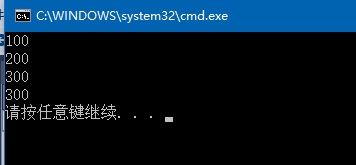C++允许对自增符号“++”,和自减符号”--“进行重载,但众所周知,前置的”++“、”--“和后置的意义是不一样的,
而且更糟糕的是,他们的前置式和后置式都是没有参数的,这就让我们的重载变得不可能了。
为了填补这个语言学上的漏洞,C++让后置式有一个int型的参数,并在它被调用的时候,
编译器自动为该int指定一个0值。 ex:
#include <iostream>
using namespace std;
//记录整百的数
class Hundreds
{
public:
Hundreds(int org = 0) { data = org - (org % 100); }
Hundreds& operator++(); // 前置(prefix)的 “++”
const Hundreds operator++(int); //后置(postfix)的 “++”
Hundreds& operator--(); //前置的 “--”
const Hundreds operator--(int); //后置的“--”
void Show() const { cout << data << endl; }
private:
int data;
};
Hundreds& Hundreds::operator++()
{
data += 100;
return *this;
}
const Hundreds Hundreds::operator++(int)
{
Hundreds oldValue = *this; //记录旧数据
data += 100;
return oldValue;
}
Hundreds& Hundreds::operator--()
{
data -= 100;
return *this;
}
const Hundreds Hundreds::operator--(int)
{
Hundreds oldValue = *this;
data -= 100;
return oldValue;
}
int main()
{
Hundreds hd(100);
//测试“++”操作符
//取出后累加:fetch and increment.
(hd++).Show(); //显示100,等价于(hd.operator++(0)).Show();
hd.Show(); //显示200
//累加后取出:increment and fetch.
(++hd).Show(); //显示300,等价于(hd.operator++()).Show();
hd.Show(); //显示300
//“--”操作符与之类似
//... ...
return 0;
}为什么后置式的返回值要是const的对象呢?
因为后置式的返回值不再是现在的变量,而是旧值,因此,类似hd++++的式子应该是不合法的。因为,
如果hd++++是合法的,则,第一个“++”的返回值就不是hd,因此,后一个"++"并不是作用于hd的函数,
让人产生混淆,所以,我们还是废了这种想法吧。所以我们让它返回const对象。
(PS:然而前置式如++++hd则是合法的,因为它的返回值正是hd的引用。)
有了上面的分析,我们就能够理解为什么在前置式和后置式都可选的情况下,我们应该尽量选用前置式。
毕竟前置式没有“oldValue”这个中间变量的羁绊。毕竟这个中间变量也是需要构造和析构的嘛。

























 553
553

 被折叠的 条评论
为什么被折叠?
被折叠的 条评论
为什么被折叠?








